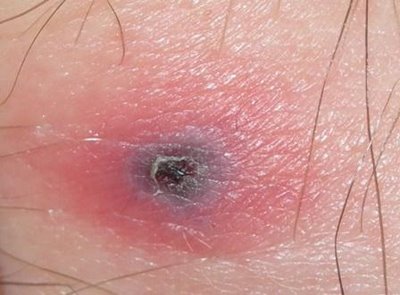Tick-borne disease (patient information): Difference between revisions
| Line 35: | Line 35: | ||
==How do I know I have Tick-borne disease?== | ==How do I know I have Tick-borne disease?== | ||
A round red rash with a 2-5 mm central black area (eschar, an area of dead tissue) as shown in the photo is suggestive of a tick bite. | A round red rash with a 2-5 mm central black area (eschar, an area of dead tissue) as shown in the photo is suggestive of a tick bite. | ||
[[Image:Tick bite.JPG| | [[Image:Tick bite.JPG|left|100px|frame|Tick bite with central black [[eschar]]]] | ||
==When to seek urgent medical care== | ==When to seek urgent medical care== | ||
Revision as of 20:30, 7 May 2010
For the WikiDoc page for this topic, click here
Editor-in-Chief: Alexandra M. Palmer
Please Join in Editing This Page and Apply to be an Editor-In-Chief for this topic: There can be one or more than one Editor-In-Chief. You may also apply to be an Associate Editor-In-Chief of one of the subtopics below. Please mail us [1] to indicate your interest in serving either as an Editor-In-Chief of the entire topic or as an Associate Editor-In-Chief for a subtopic. Please be sure to attach your CV and or biographical sketch.
What is Tick-borne disease?
Tick-borne diseases are diseases or illnesses transmitted by ticks. Hard- and soft-bodied female ticks are believed to make a poison that can cause tick paralysis in children.
While most ticks do not carry diseases, some ticks can carry bacteria that can cause:
What are the symptoms of Tick-borne disease?
Watch for the symptoms of tick-borne disease in the weeks following a tick bite -- muscle or joint aches, stiff neck, headache, weakness, fever, swollen lymph nodes, and other flu-like symptoms. Watch for a red spot or rash starting at the location of the bite.
The symptoms below refer more to the problems resulting from the bite itself, not the diseases that a bite may cause. Some of the symptoms are specific to one variety of tick or another but not necessarily common to all ticks.
- Apnea (breathing stopped)
- Blisters
- Difficulty breathing
- Rash
- Severe pain at bite site (some varieties), lasting for several weeks
- Swelling at bite site (some varieties)
- Weakness
- Uncoordinated movement
What causes Tick-borne disease?
Who is at risk for Tick-borne disease?
How do I know I have Tick-borne disease?
A round red rash with a 2-5 mm central black area (eschar, an area of dead tissue) as shown in the photo is suggestive of a tick bite.

When to seek urgent medical care
Prevention of Tick-borne disease
Avoid places where ticks reside. Ticks live in wooded or grassy fields.
At-home treatment
Remove the tick. Be careful not to leave the tick's head stuck in the skin.
Where to find medical care for Tick-borne disease
Directions to Hospitals Treating Tick-borne disease
What to expect at the emergency room
The symptoms will be treated as appropriate. Long-term treatment may be needed if complications develop. Preventive antibiotics are often given to people who live in areas where Lyme disease is common.
What to expect (Outlook/Prognosis)
Most tick bites are harmless. The outcome will depend on what type of infection the tick may have been carrying and how soon appropriate treatment was begun.